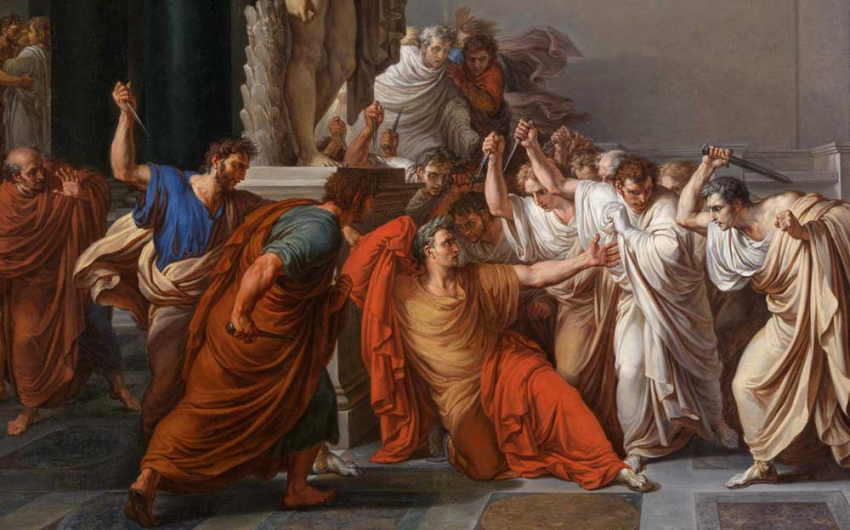“The deadly facts herein revealed lead me to wonder that this monster, interest, has not devoured the whole human race…” –Napoleon Bonaparte
“The Central Bank is an institution of the most deadly hostility existing against the principles and form of our Constitution… I believe that that the banking institutions are more dangerous to our liberties than standing armies. Already they have raised up a moneyed aristocracy that has set the Government at defiance. The issuing power should be taken from the banks and restored to the people to whom it properly belongs. If the American people ever allow the banks to control the issuance of their currency, first by inflation and then by deflation, the banks and corporations that grow up around them will deprive the people of their property until their children will wake up homeless on the continent that their fathers occupied.” –Thomas Jefferson
Some of the most important assassinations in human history were carried out when leaders became a threat for the usurious money lenders and ended, or threatened to end, usury. The international banking families of modern times are the true heirs of the money lenders of ancient times. The real reason these assassinations are concealed in standard historical discourse lies in the fact that all modern historical discourse in controlled by these banking families. Because of its devastating effects on society, resulting from concentration of wealth in a few hands, usury has been strictly banned in both Islam and Christianity.
The first famous assassination is that of Julius Caesar (100-44 BC). He was killed at age 55 in a most dramatic murder that took place in the Roman Senate. If you look at the standard explanations of his assassination, you will find that he was killed because of fear that he might crown himself king of Rome, or because he had disrespected the Senate, etc. But the real reason is concealed and never mentioned in “standard” history.
In a small book “A History of Central Banking and Enslavement of Mankind”, published in 2014, Stephen Mitford Goodson, who worked for the South African Reserve Bank, has revealed the real reason behind Julius Caesar’s assassination. Incidentally Mitford, who headed the Abolition of Income Tax and Usury Party of South Africa, died mysteriously in 2018 at age 70. It is strongly suspected that he too was assassinated for exposing the bankers and for his fight against usury and income tax.
Initially, the Romans used a barter system, in which cattle were employed. With the passage of time Romans moved to irregular lumps of copper or bronze as money. These lumps, known as aes rude (rough metal) were weighed for each transaction. As Rome became richer and commerce and trade increased, the Roman Treasury began issuing stamped metal (aes signatum), initially in the form of ingots weighing 3.5 pounds each, and carrying the images of animals, like a cow, an elephant, an eagle, etc. These stamped ingots, initially of copper, and subsequently of bronze, had the backing of the state.
In 289 BC, instead of these 3.5 pound ingots, much lighter disc shaped bronze coins were introduced and their value as stated on them. It is important that the value of these discoids was not based on the metallic content but on law – the value was what the state stated or stamped on them. In this sense these coins were fiat money – their value was not based on the actual metallic content but on what the state engraved on these. In the words of Goodson: “While fiat money is much criticized in some quarters, … there is nothing wrong with it, as long as it is issued by the government, not by private bankers, and is carefully protected against counterfeiters.” One may recall that, in his profound book Arth Shastar, Kotlia Chankia has devoted many pages on how to deal with counterfeiters!
In general, the Roman leaders were frugal and honest. There was zero inflation as the means of exchange was strictly regulated. But a deeply significant development took place in the year 227 BC that destroyed the traditional money system and corrupted the leadership. In this year the Roman aristocracy, the patrician elite, obtained the power to mint silver coins. The power to mint Roman money passed into private hands in this year. The Roman patrician elite is the true precursor of the international banking families of today, that among others, own the US Federal Reserve and have the power to print dollars and loan them to the government of the US on interest!
A most disturbing example of private fiat money is the case of a patrician who went into the “Temple of Juno Moneta (from where the word money is derived) and converted a sack full of silver denarii to five times its original value by the simple expedient of stamping a new value on the coins.” Thus by such a fraudulent tactic he increased his wealth five times!
Since there was hardly any silver in Italy, the Roman armies had to expanded to conquer territories from where silver could be obtained! As a result, Roman peasants had to be inducted into the army. To manage the farms, that were falling into a poor state, slave labor from Africa had to be imported. Corn production fell and wheat had to be imported from North Africa. All this was a major consequence of the decision to have privately minted silver coinage. Somewhat analogously, today, the U.S., with its petro-dollar, wages wars abroad for oil and gas resources.
Economic deprivation, particularly among the slaves from Africa, caused a lot of discontent. Eventually, in 326 BC, debt bondage was abolished. In this system a person who had taken a loan would pledge his services as security for the loan. In case of nonpayment of loan, the debt had to worked off. However, with the introduction of privately minted money, usury gained ground. The first Jews arrived in Rome in 161 BC. They were mostly craftsmen, peddlers and shop keepers. In their capacity as shopkeepers they engaged in usurious money lending also. In 139 BC, those Jews who were not Roman citizens, were expelled for proselytizing but soon returned.
Julius Caesar was born in an aristocratic family in 100 BC. He practiced briefly as a lawyer before becoming a brilliant military commander. In the year 48 BC he defeated Pompey the Great and became the undisputed master of Rome. Goodson writes: “On his return to Italy in September 45 BC, Caesar found the streets and cities crowded with homeless people, who had been forced off the land by usurers. 30,000 people had to be fed daily at the public granary. Usury was flourishing with disastrous consequences. The principal usurers, many of whom were Jewish, were charging interest rates as high as 48%.” It may be noted that Jews do not practice usury between themselves – their religion allows them to give usurious loans only to non-Jews.
In his 2011 book “Sketches from Roman History” T.E. Watson writes: “He [Julius Caesar] recognized the profound truth that money is a national agent, created by law for a national purpose, and that no classes of men should withhold it from circulation so as to cause panics, in order that speculators could advance the rates of interest, or could buy up property at ruinous prices after such panic.” Julius Caesar carried out social and monetary reforms. Free housing was provided to 80,000 poor families, the pay of soldiers was raised from 123 to 225 denarii, repayment of property was done at much lower valuations that were held prior to 49-45 BC civil war and so on.
The monetary reforms that Julius Caesar carried out led to his murder. He took the power of issuing money back from the patricians and gave it to the state. This was a grievous blow to those who could mint money, literally and metaphorically, and have wealth by sitting idle and by merely loaning money on high interest. He also forced the patricians to invest their money instead of hoarding it. Cheap metal coins were issued instead of the silver coins. Further it was decreed that a) interest could not be charged at more than 1% per month, b) interest could not be charged on interest, and c) total interest charged could never exceed the capital loaned. These measures severely curtailed the earnings of the patricians who did no work and just minted and loaned money usuriously, and amassed unlimited wealth and power.
Goodson writes: “These measures enraged the aristocrats and plutocrats whose ‘livelihood’ was now severely restricted. They therefore conspired to murder Caesar, the hero of the people. On that fateful morning of March 15, 44 BC, only four years after assuming power he arrived at the Senate building unarmed, having dismissed his military guard, who had previously been in constant attendance. Surrounded by 60 conspirators he was stabbed to death and received 23 wounds.”
To consider the history of Britain in this context would require a somewhat lengthy discourse. However, it is known that with the establishment of the Bank of England in 1696, the grip of the international banking families on England became much tighter. They had struggled and intrigued for almost a century to gain control of Britain. However, the war against Napoleon had very much to do with Napoleon’s views against usury. In the foreword to the 1999 English translation, by James Glbb Stuart (“Napoleon and Islam”), of Christian Cherfils’ 1914 French book, English writer David Musa Pidcock states: “I believe it was Lord Acton, a little later on in the 19th century, who endorsed Napoleon’s view – together with that of David Ricardo and Abraham Lincoln – that the world would not be free-of-war until the tables on the money changers are overturned once and for all.” Pidcock also points out that Wellington “was a tool of the Rothschilds.”
It is important to point out that the war waged against France by England lasted from 1792-1815. In parallel England also waged a war against America from 1812-14. Both wars were instigated by the Rothschilds. The war against America was instigated because the US had refused to renew the charter of the Rothschild controlled Bank of America, which was the central bank of the US from 1791-1811. In the words of Goodson, the “British Prime Minister Spencer Perceval (1809-1812) tried to stop this completely futile war, but was assassinated on May 11, 1812, in the lobby of the House of Commons by John Bellingham, a political radical, who had been set up by Rothschild.” Perceval knew the intricacies of high finance very well because he had been the Chancellor of the Exchequer, an office to which he was appointed on March 28, 1807.
The French campaign in Egypt and Syria took place under Napoleon Bonaparte who spent three years and two months in the region (1July 1798- 2 September 1801). Christian Cherfils writes: “Even before leaving France, Bonaparte had decided to study the Quran. Under the significant heading of Politic and Morals, he had ordered them to obtain for his Camp Library, copies of the Old and New Testaments, the Quran, the Vedas, Mythology and Esprit de Lois bt Montesquieu.” In Egypt Napoleon interacted with the scholars of the country, particularly the Ulema of Al Azhar.
He was so deeply influenced by the Quran that he wrote to Sheikh El Mesiri on August 26, 1798: “I hope the time will not be long before I can bring together all men of wisdom in this country, and set up a balanced regime, founded upon the principles of Quran, which are the sole truths, and which alone can bring happiness to man.” A document from the Commander’s office dated 16th August 1799 records the great pomp with which the Prophet’s birthday was celebrated. “Nothing so splendid had been seen in the memory of man” records the document. It states: “All the army units in Cairo, illuminated by a multitude of torches, paid a visit to the Sheikh El-Bekry where the commander-in-chief [Napoleon] had dined, along with Moustafa-Pacha and all the principal officers taken prisoner at the Battle of Aboukir. The commander-in-chief was present at the readings which were given of various Arab poems in honor of the Prophet recited to him, after which, surrounded by the great sheikhs, he ordered prayers and had the genealogy of the Prophet recited to him.”
In view of the foregoing it is almost certain that the ban on usury imposed by the Quran must have been in his knowledge. When he became First Consul on November 9, 1799, Napoleon’s first action was the establishment of the Bancque de France on January 18, 1800. It was established as a joint stock company and began operations, almost a month later, on February 20. Goodson writes: “This bank replaced the 15, mainly Jewish, private banking houses which had been deeply involved in the events leading up to the French Revolution 1789-1799. These banks had charged rapacious rates of interest on loans to the French crown, to the extent that prior to 1789, it was allocating over 50% of its budget expenditure to interest.”
On April 14, 1803 he abolished the right of two rival banks to issue currency. These were the Caisse d’Escompte de Commerce and the Comptoir Commercial. He pointed out that a single currency issuing bank “can be more easily watched than several concerns – both by the Government and the public.” This step must have deeply disturbed and enraged the scheming Rothschilds and their related banking families.
Therefore, a coalition of forces comprising Austria, Prussia, Russia, Spain and Sweden, bankrolled to the tune of 100 million pounds by the Rothschilds, declared war on France. The coalition had 600,000 troops and Napoleon had less than one third of that number. Normally he would have been compelled to borrow money from bankers for the war effort. But, on December 20, 1803, Napoleon sold Louisiana to the US for 3 million pounds and thus surprised the bankers.
It is extremely important to note that “Napoleon was so suspicious and distrustful of bankers that he personally supervised the operations of the Treasury, lest the secrets of his monetary policy leak out and be exploited by speculators. He was thus his own banker, who controlled both the creation and distribution of money and credit, to the chagrin of international bankers, particularly the Rothschillds, who were virtually excluded from operating in continental markets,”
By 1806 the Bank’s capital had risen to 90 million francs and the franc was the most stable currency in Europe. Such a situation was not acceptable for the Rothschilds. Therefore, after a brief interlude of peace, a new war broke out in 1806. Napoleon was not allowed to rest in peace and his resources had to be consumed in needless wars prompted by the Rothschilds. He was compelled to go to war with Russia. His winter retreat became a disaster and weakened his power considerably. Eventually, in 1815, Napoleon was defeated at Waterloo. He was fighting against a coalition of Austria, Prussia and Britain, who had been loaned 10 million pounds by the Rothschilds for the latest war.
It has now been established that Napoleon was poisoned at St. Helena, where he had been imprisoned. This has been established by Ben Weider and Sten Forshufvud, whose book on Napoleon’s assassination has been translated into 28 languages and sold over a million copies. Napoleon was only 51 when he died of arsenic poisoning on May 5, 1821. As Ben Weider wrote in his article “The Assassination of Napoleon” (it can be accessed on the web): “You know, people often ask me how I can be so sure that Napoleon was poisoned. After all, he has been dead for 176 years. The answer is relatively easy. Eight eyewitnesses told me so (through their books) and the information they supplied was confirmed through nuclear science. These eyewitnesses were in contact with Napoleon on a regular basis and reported what they saw in their diaries which they published once they returned home after Napoleon’s death.”
The levels of arsenic in Napoleon’s hair, which was tested at the Harwell Nuclear Research Laboratory of London, confirmed that he was indeed poisoned. The results were also confirmed by the FBI. The court historians have spread the lie that Napoleon died on cancer. Weider asks: “If Napoleon died of cancer, then why did he die fat and not show any symptoms of cancer? It’s simply because he didn’t die of cancer.” Goodson states: that Napoleon’s assassination “would undoubtedly have been the work of a Rothschild assassin, which conforms to a pattern, repeated consistently during the past two centuries of assassinating all leaders who propose, institute and maintain systems of usury-free banking.”
Why was Abraham Lincoln assassinated? War is great business for the bankers, provided they, instead of the government, have the power to print or mint money. They issue loans to all warring sides at high interest, and the winning side ensures that the loans of both sides are squeezed out of the losing side, including the interest on the loans. This ruthless technique is usually known as the Rothschild formula. The American civil war (1861-65) was a Rothschild intrigue.
Former employee of the American Security Agency (ASA), author Robert Gaylon Ross Sr. writes: “The House of Rothschild financed the War of 1812 between the United States and the British. This failed attempt to bring the United States back under ‘The Crown’, caused the Rothschilds to create a secret society in America, called the Knights of the Golden Circle (K.G.C.).” By “The Crown” is meant the City District of London, the hub of the banking elite, which, like the Vatican, is independent of the laws of the land. The K.G.C. spread rapidly in both the North and the South of the U.S. and had a deep foothold by the time of the Civil War. According to Robert Gaylon Ross Sr., “In fact, all of Lincoln’s cabinet except two, including him, were members of this secret group. The entire cabinet of the South were members of the K.G.C.”
In the words of Deanna Spingola: “The London Rothschilds placed agent provocateurs in the U.S. including Judah P. Benjamin, a ‘staunch supporter of slavery’, who became General Lee’s top financial advisor… August Belmont, Rothschild’s agent in New York and John Slidell, Belmont’s nephew by marriage, was in New Orleans. They each maneuvered circumstances to initiate the conflict.” Thus the Rothschilds had their men on both sides, the North and the South, as the two sides went to war.
Having instigated the civil war, the Rothschilds offered to loan money to the Lincoln government at 24%-36% interest. This rate was so high that Lincoln, on the advice of Colonel E.O. Taylor, decided to issue Treasury dollars, known as greenbacks. In a letter written to Taylor in December 1864, Lincoln stated that at a time when, “[M]y shoulders, though broad and willing, were weak, and myself surrounded by such circumstances and such people that I knew not whom to trust, then I said in my extremity, ‘I will send for Colonel Taylor; he will know what to do.’” It was in January 1862, when Lincoln called him and asked him “What shall we do?”. Taylor had, in Lincoln’s own words, replied: “Why, issue treasury notes bearing no interest, printed on the best banking paper. Issue enough to pay off the army expense, and declare it legal tender.”
Lincoln issued a little over $449 million in greenbacks by April 1862. It carried no interest to be paid to any banker and the only cost it incurred was the cost of paper, printing, and distribution. In the words of Goodson: “Lincoln’s defiance of Lionel Rothschild and his uncle James resulted in his assassination on the night of April 15, 1865” by John Wilkes Booth. According to author Des Griffin: ”Booth’s grand-daughter, Izola Forester, states in ‘This One Mad Act’ that Lincoln’s assassin had been in contact with mysterious Europeans prior to the slaying, and had made at least one trip to Europe. Following the killing, Booth was whisked away to safety by members of the Knights of Golden Circle.”
In her book Forester has also stated that Booth had, at the time of the assassination $6,500 in cash on his person, and planned to escape to a country that had no extradition treaty with the U.S. Such a huge amount of cash in those days could have only come from the bankers. The New York Tribune of April 19, 1865 stated that Booth was a member of the Order of the Knights of Golden Circle and that “he was merely the instrument of the order to which he belonged, to remove Lincoln.” After Lincoln’s assassination these greenbacks were withdrawn from circulation gradually. By 1879 they had been completely withdrawn. Lincoln had said: “[W]e gave the people of this republic the greatest blessing they ever had – their own paper money to pay their debts.”
Such is the control of narrative in these matters that while various reasons are stated for the assassination of John F. Kennedy, two reasons are completely omitted in the mainstream media. These are a) his attempts to stop Israel’s nuclear program, and b) the issuance of the U.S. Treasury dollars with the intention of replacing the Federal Reserve notes. Kennedy had issued these Treasury dollars after almost a gap of a century after Lincoln’s fatal issuance of greenbacks. How many people know that John Kennedy had printed U.S. Treasury dollars, and put them into circulation? After his assassination the circulation of these Treasury dollars was stopped. The Federal Reserve is privately owned by the Rothschilds, the Rockefellers, the Morgans, and a few other international banking families.
The reasons for assassinating any leader who dares to take away the power of printing money from the international banking families, was stated very clearly in an article in the London Times, shortly after Lincoln had issued his greenbacks. It stated: “If that mischievous financial policy, which had its origin in the North American Republic, should become indurated down to a fixture, then the Government will furnish its own money without cost. It will pay off debts and be without a debt. It will have all the money to necessary to carry on its commerce. It will become prosperous beyond precedent in the history of the civilized world. The brains and wealth of all countries will go to North America. That government must be destroyed or it will destroy every monarchy on the globe.”














